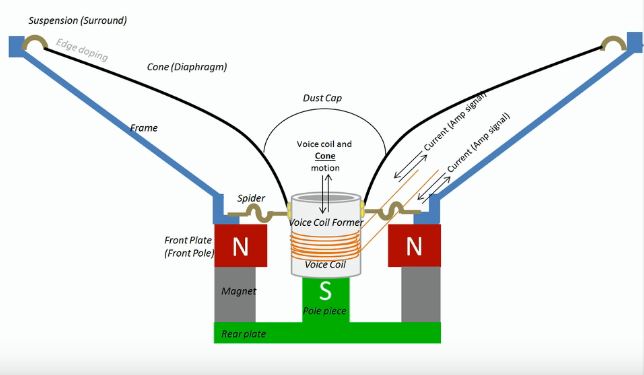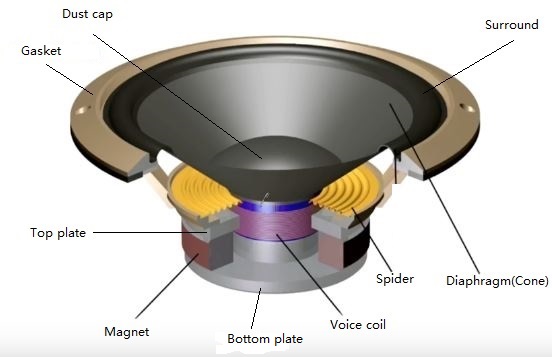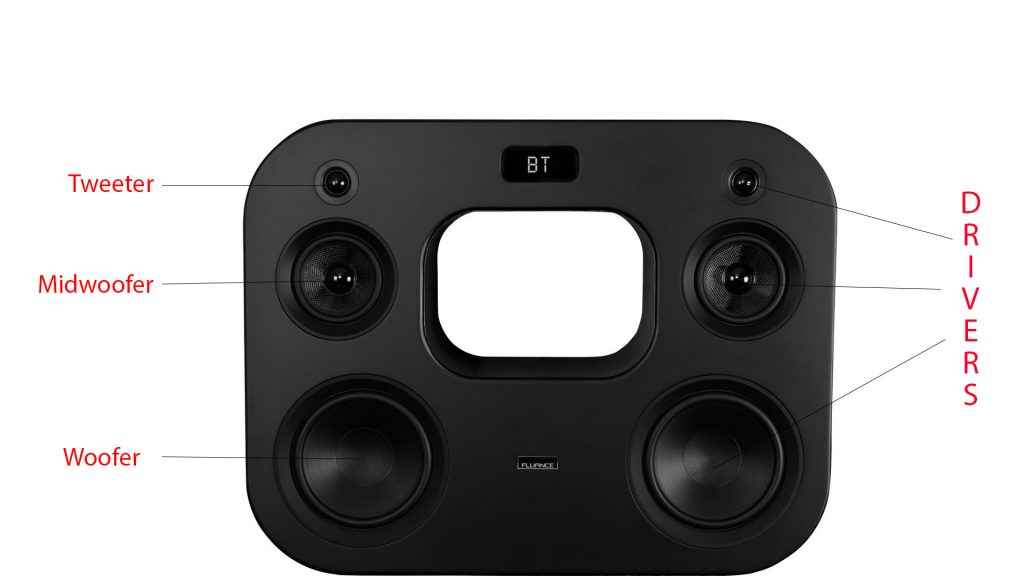AudioReputation is reader-supported. When you buy through links on our site, we may earn an affiliate commission Learn More
Speakers might look complicated but they are actually really simple devices and in order to understand their working principle, you need just a basic understanding of electromagnetism and sound waves.
Speakers transform electrical signals into sound waves and that’s the simplest definition of their purpose. The working principle is a little bit more complicated but we will get to that.
Table of Contents
How Do Speakers Work?
Speakers convert electrical signals into sound waves by using a coil of wire (called a voice coil) that is suspended in a magnetic field. When an electrical current is passed through the voice coil, it moves back and forth, creating vibrations that cause a paper or plastic cone (called a diaphragm) attached to the coil to vibrate. This vibration pushes and pulls on the air, creating sound waves that we can hear.
Parts of A Speaker
Every speaker has at least three parts – enclosure, driver (or drivers), and electronic components (crossovers, amplifiers).
Drivers – Speaker drivers are the most important parts of every speaker. The drivers are in charge of transforming electrical signals into sound. Enclosures and electronic components are important, too but their purpose is to improve the sound quality while the drivers actually create the sound. Speaker drivers are often called speakers which is not completely correct. Speaker is the term that defines the whole package (drivers + enclosure + electronic components). Speaker drivers are just one part of the speaker.
Enclosure/Housing/Cabinet – The box inside which all the drivers and other components are installed is called enclosure. Depending on the type and size of the enclosure, the sound will be different.
Electronic components (crossovers and amplifiers) – Many speakers have amplifiers. Their purpose is to amplify the electrical signal and improve the accuracy of the output signal. Some speakers (those with two, three, or multiple drivers) have crossovers which redirect signals of different frequencies to dedicated drivers (woofers, midrange woofers, tweeters).
Speaker Driver
Driver is the part of the speaker that actually transforms all the electrical signals into sound. It consists of several parts that are glued together.
At the bottom of the driver, there’s a rear (bottom) plate and a pole piece (they are made of metal). A ring-shaped permanent magnet is placed onto the bottom plate and then glued to the top (front) plate. The voice coil windings are held by the voice coil former which fits the pole piece. Two ends of the voice coil are attached to the solder terminal (which is located somewhere on the frame). The amp is also connected to the solder terminal. When the electrical signal from the amp (alternating current) is fed to the coil, the coil becomes an electromagnet and reacts with that ring-shaped permanent magnet. This basically means that the voice coil moves back and forth depending on the orientation of the poles (electromagnet changes the orientation of the poles if the current flow is reversed). The electrical signal fed to the coil constantly changes the flow of the current causing the voice coil to move.

Picture 1 – Parts of the speaker driver (Source – YouTube)
The metal frame (basket) is glued to the top plate and it holds the speaker cone (diaphragm).
Cone/Diaphragm is the part that creates the sound waves (converts the mechanical motion of the voice coil into sound). The diaphragm is glued to the voice coil former and to the rubber surround which is the thing that keeps the diaphragm in place (along with spider). The diaphragm is glued to the frame.
The spider is the part that keeps the voice coil in position and ensures that the voice coil only moves along the axis. The spider is glued to the frame and to the voice coil.
The dust cap covers and protects the voice coil and internal parts of the speaker.

Picture 2 – Speaker driver cross section
When the electrical signal from the amp (current) is fed into the coil, the coil moves back and forth and along with the coil, the diaphragm (cone or dome) moves since it’s glued to it. The diaphragm basically gets pushed and pulled by the voice coil. The diaphragm pushes and pulls the air in front of it and creates soundwaves (sound pressure waves). These waves come to our eardrums and cause them to vibrate. The eardrum vibrations are sent to our brain as electrical signals and then interpreted as sound.
Since the electrical signal can be interpreted as a wave, the loudness and frequency of the output sound (which is also a wave) are determined by the input signal. The frequency of the electrical signal determines the speed of the voice coil movements which corresponds to the frequency of the output sound. The amplitude of the input electrical signal determines the distance the voice coil has to cover which corresponds to the loudness of the sound (sound pressure level).
Now, let’s think about the last two sentences. Is it possible for one driver to produce all the audible frequencies (20Hz to 20kHz) equally well? Larger drivers have larger cones which means they are heavier and harder to move/vibrate – they are not good enough when it comes to high-frequency reproduction since they cannot move fast. On the other hand, small driver cones can vibrate at a greater rate (they can move faster) but aren’t good enough for low-frequency reproduction (it’s difficult to make them vibrate at slow rates). That’s why many manufacturers make speakers with multiple drivers – each driver is in charge of reproducing a certain range of frequencies.
Types of Drivers
Based on the size, the drivers can be divided into 3 groups:
Woofers – The largest drivers (usually larger than 5 inches). They are in charge of low frequencies.
Midrange drivers (midrange woofers or midwoofers) – Smaller than woofers but larger than tweeters (usually 3-5 inches). They are in charge of midrange frequencies.
Tweeters – The smallest drivers (usually 1-inch drivers or even smaller). They are in charge of high frequencies.
There are speakers with only one driver (full-range driver) but there are also many speakers with two (woofer and tweeter), three, or even multiple drivers. Speakers with two drivers are called 2-way speakers and speakers with three drivers are called 3-way speakers.

Picture 3 – Different types of drivers in a 3-way speaker (Fluance Fi70)
The Importance of The Crossover
In order for different drivers (woofers, midrange woofers, and tweeters) to work together you need a device that would break the input signal into two or three smaller output signals (low, mid, and high-frequency signals) and send them to appropriate drivers. These devices are called crossovers.
Depending on the number of the output signals they produce, the crossovers are divided into 2 groups – 2-way crossovers (they break the input signal into 2 output signals – low frequency signal and mid+high frequency signal) and 3-way crossovers (they break the input signal into 3 output signals – low-frequency, mid-frequency, and high-frequency signals and they are all sent to different drivers). 2-way and 3-way crossovers are the most common types but there are also speakers with 4 or more different drivers inside one enclosure that require 4-way (or n-way) crossovers.
2-way crossovers consist of 2 parts – low-pass and high-pass filters. The low-pass filter passes the low frequencies to the woofer and blocks the high frequencies. The high-pass filter passes high-frequencies to the tweeter and blocks all the low frequencies. 2-way crossovers are usually made of inductors and capacitors. Capacitors are used as high-pass filters (they will only conduct electrical signals above certain frequency) while the inductors are used as low-pass filters (they will only conduct electrical signals below certain frequency).
3-way crossovers also have low-pass and high-pass filters, but they also have an additional band-pass filter. The band-pass filter will pass a certain range of frequencies and it will send them to the midrange woofer (for example all the frequencies from 150Hz to 1800Hz).
You might think that a 3-way speaker should always sound better and more accurate than a 2-way speaker but that’s not the case. 2 drivers are sometimes better than 3 drivers. The sound quality depends on many factors – the quality of the installed components inside the crossover, the crossover setup, quality and type of the enclosure, etc.
Based on the power source, all the crossovers are divided into two groups – active and passive. Passive crossovers are more common and you can find them in many speakers. They are powered by the input signal and they are built inside the speakers. Active crossovers need an external power source but they give you more freedom when it comes to fine-tuning and adjusting the sound (but they are much more expensive and more difficult to install).
The Importance of The Enclosure
The third part of a speaker is the enclosure. This is the box (made of wood, MDF, plastic, or some other material) that holds the drivers and other electronic components. The sound would exist even without the enclosure but there are a few reasons for using it. The first reason is the most basic one – it’s more convenient to install everything inside one compact box. The enclosure is also very important for sound quality. It is supposed to eliminate the driver vibrations and handle the air (sound) that gets pushed behind the driver cone (diaphragm). The diaphragm vibrates due to the movement of the voice coil – it pushes the air toward our ears but it also pushes it back toward the enclosure (it moves back and forth). Different types of enclosures handle this air (or soundwaves, if you want) in different ways.
There are two basic types of enclosures – sealed and ported. Sealed (aka acoustic suspension) enclosures are more common. They have no holes for the air to ‘’escape’’ so the air that gets pushed back is trapped inside of the enclosure. The air gets piled up behind the cone and because of all the air, it’s much harder for the diaphragm to move back and forth. That’s why these speakers are less efficient and the electrical signal has to be boosted. Sealed enclosures make the sound more accurate but the bass is tighter and controlled.
Ported enclosures have holes (usually on the rear or on the front panel). These holes are known as ports (bass reflex ports) and they allow the air to ‘’escape’’ the box. The speakers with ported enclosures are louder, more efficient, and easier to drive but they don’t produce equally accurate sound as speakers with sealed enclosures.
Enclosures with a passive radiator(s) are somewhere in between the previous two types. They have ports but inside these ports, there are passive drivers (they don’t have voice coils and are not connected to the amplifier). These passive drivers (passive radiators) vibrate when the sound waves are created by the active drivers. Passive bass radiators combine the benefits of sealed and bass-reflex enclosures – the speakers with passive bass radiators produce more accurate sound than the bass-reflex speakers and they are more efficient than the sealed speakers.
Frequently Asked Questions
Speakers move in “wiggles” at different speeds, slowly for low-frequency sounds and faster for high frequencies. When we superimpose these different speeds on top of each other, these different vibrations produce different kinds of sounds we hear. There are tons of different vibrations that are produced that make up the audio we hear. It’s all a matter of how the speaker moves.
Speakers vibrate due to the electricity passing through them. A voice coil present in the unit interacts with the permanent magnet’s magnetic field when current flows through it. This causes the coil to produce a mechanical force that makes the speaker vibrate.
The amount of power that runs through a speaker when it’s operating determines how loud it will be. If you have amplifiers, the power flowing through them will also add to the loudness. Other factors like the size of the speaker, insulation, and speaker cone reflex also determine its volume. So, if you want to make your speaker louder, make sure it has the right wattage, is big, has a small, tight cone and has good insulation.

Hello, my name is James Longman.
I’m a writer and editor at AudioReputation. I disassembled my first portable AM/FM radio when I was only 8. At the age of 11, I burned the circuit board on my old boombox cassette player. I’m not going to explain how but it was reckless and stupid.
Since then, I have become much more careful around radios, boomboxes, and other audio devices (at least, I like to think so) but I have never lost the passion for audio equipment. Throughout 20 years of my professional career, I’ve been working for various audio equipment manufacturers and even started building speakers on my own in my little workshop.
I love the work we do here at AudioReputation. Testing, comparing, and evaluating all kinds of audio devices (speakers, soundbars, headphones, home theater systems, etc.) is something I truly enjoy. I try to be unbiased and give you my honest opinion on every piece of equipment I test. Still, you should take my reviews with a pinch of salt and always be just a little bit skeptical. The fact that I liked some speaker or soundbar doesn’t mean that you are going to love it. If you have the opportunity, you should test it/hear it before buying it.

